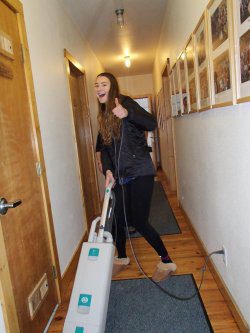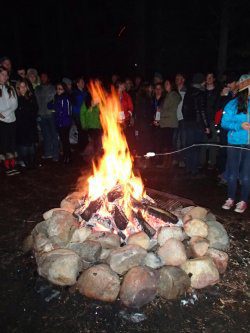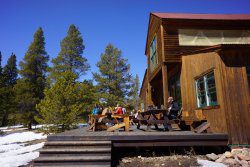 The week leading up to Parents’ Weekend was jam-packed and we were all was itching for our families to arrive. Everyone worked their hardest during both chore sessions on Friday to make HMI look as beautiful as possible. As we boarded the bus into town on Friday night, butterflies were fluttering in all of our stomachs. Seeing our families for the first time in two months was certainly an emotional experience, but the parents surely shed the most tears. Dinner in town was a great chance for everyone to see Leadville in all its grandeur, and catching up was awesome. The bonfire later that night was very HMI, and Danny’s list of rules for Expedition Behavior was one hundred percent true. As usual, we all slept like rocks that night and in the morning we were right back at it. On Saturday we took a walk with our families for AMX, and we were admittedly a little disappointed that they didn’t have to run and experience the full force of the altitude! Classes were brief but inspiring, and having our dinner served to us was surely a treat. Following dinner, the slideshow showed our families a glimpse into our new lives. We hope they enjoyed seeing our special little world at 10,000 feet.
The week leading up to Parents’ Weekend was jam-packed and we were all was itching for our families to arrive. Everyone worked their hardest during both chore sessions on Friday to make HMI look as beautiful as possible. As we boarded the bus into town on Friday night, butterflies were fluttering in all of our stomachs. Seeing our families for the first time in two months was certainly an emotional experience, but the parents surely shed the most tears. Dinner in town was a great chance for everyone to see Leadville in all its grandeur, and catching up was awesome. The bonfire later that night was very HMI, and Danny’s list of rules for Expedition Behavior was one hundred percent true. As usual, we all slept like rocks that night and in the morning we were right back at it. On Saturday we took a walk with our families for AMX, and we were admittedly a little disappointed that they didn’t have to run and experience the full force of the altitude! Classes were brief but inspiring, and having our dinner served to us was surely a treat. Following dinner, the slideshow showed our families a glimpse into our new lives. We hope they enjoyed seeing our special little world at 10,000 feet.
In preparation for out last expedition in the canyons of Utah, we spent a full day learning about outdoor wilderness first aid. Third expedition is quite unique because we can gain independent student travel if we prove to our instructor team that we are capable of hiking without them during the day. One way to prepare us for this journey is to talk about first aid! We spent Monday morning going over the procedures and protocols we would need to utilize if someone got hurt. The first step we take when assessing a patient is “Scene Size-Up,” which is when the caregiver quickly goes through a checklist in their head to keep themselves safe and to evaluate the victim before talking or touching them. The next step in the patient assessment process is to do an initial assessment. This is when the caregiver contacts the patient to see if they are conscious, gets consent from the patient to treat them if they are conscious, and controls the patient by figuring out what happened and stabilizing the spine. The next thing that needs to be done is checking for threats of life by going through the A-B-C-D-E’s. This stands for airway, breathing, circulation, disability, and expose/environment. The caregiver then goes through a head-to-toe check where they put pressure on various parts of the body to see if the victim is in pain. The next step in the process is to check vital signs (level of responsiveness, heart rate, respiratory rate, and skin color). The last thing the caregiver does is go through the victims SAMPLE history by asking them about history that would be valuable for them to know. After learning about first aid we feel a lot more prepared to be traveling in the backcountry!
checklist in their head to keep themselves safe and to evaluate the victim before talking or touching them. The next step in the patient assessment process is to do an initial assessment. This is when the caregiver contacts the patient to see if they are conscious, gets consent from the patient to treat them if they are conscious, and controls the patient by figuring out what happened and stabilizing the spine. The next thing that needs to be done is checking for threats of life by going through the A-B-C-D-E’s. This stands for airway, breathing, circulation, disability, and expose/environment. The caregiver then goes through a head-to-toe check where they put pressure on various parts of the body to see if the victim is in pain. The next step in the process is to check vital signs (level of responsiveness, heart rate, respiratory rate, and skin color). The last thing the caregiver does is go through the victims SAMPLE history by asking them about history that would be valuable for them to know. After learning about first aid we feel a lot more prepared to be traveling in the backcountry!
Wilderness first aid was a busy day full of first aid scenarios and lots of learning, as well as many laughs. We learned how to deal with cuts and burns, as well as how to help support expedition mates with head, spine, and musculoskeletal injuries. To practice, each tarp group had a “patient” test their other tarp mates with fake injuries, including a facial gash from a game of rock toss—where students used hot sauce as fake blood—and the tarp mates had to support their injured friend using the skills that we learned earlier in the day. When learning about cut and burn support, Sophie the apprentice came into the library with fake cuts all over her hands and legs. She even had an “impaled” pencil in her leg! During the musculoskeletal injury lesson, all of the students made splints for their “patients” using sleeping pads, sticks, and jackets–all materials available in the canyons. The day was long, but we all felt much more prepared for the independent student travel during third expedition, and we hope that we will not have to use anything that we learned during wilderness first aid.
 Today was prep day for third expedition! This is the student-led expedition, and, likewise, the preparations for the expedition were also very student-run. We wrote our own RAD(route and description) plans for the entire trek, picking campsites, deciding daily mileage, seeking out the water spots, and, for the most part, planning our own trips. After making sure our RAD plans were all set for the entire journey, we began packing. This time around in the canyons it is supposed to be a warm and sunny 70 degrees during the day, so we packed lightly, with many fewer layers than the previous two expeditions. However, that space we created was taken up with the mountains of food we prepared in the rations room, which included as many pounds of Jolly Ranchers, beans and an assortment of veggies, carbs, and protein. After packing our clothes and opther personal items, food, and group gear (such as the tarp, stove, and pot), we had student-lead classes that recapped various basic skills, map skills, leadership skills, and safety skills that we learned on first expedition. The entire day, guided and directed by our SELs (student expedition leaders), was accomplished without much input from faculty. Thinking back to first expedition, we have truly come a long way with our backcountry skills. We can’t wait to explore the canyons again and have the opportunity to exercise our self-reliance!
Today was prep day for third expedition! This is the student-led expedition, and, likewise, the preparations for the expedition were also very student-run. We wrote our own RAD(route and description) plans for the entire trek, picking campsites, deciding daily mileage, seeking out the water spots, and, for the most part, planning our own trips. After making sure our RAD plans were all set for the entire journey, we began packing. This time around in the canyons it is supposed to be a warm and sunny 70 degrees during the day, so we packed lightly, with many fewer layers than the previous two expeditions. However, that space we created was taken up with the mountains of food we prepared in the rations room, which included as many pounds of Jolly Ranchers, beans and an assortment of veggies, carbs, and protein. After packing our clothes and opther personal items, food, and group gear (such as the tarp, stove, and pot), we had student-lead classes that recapped various basic skills, map skills, leadership skills, and safety skills that we learned on first expedition. The entire day, guided and directed by our SELs (student expedition leaders), was accomplished without much input from faculty. Thinking back to first expedition, we have truly come a long way with our backcountry skills. We can’t wait to explore the canyons again and have the opportunity to exercise our self-reliance!